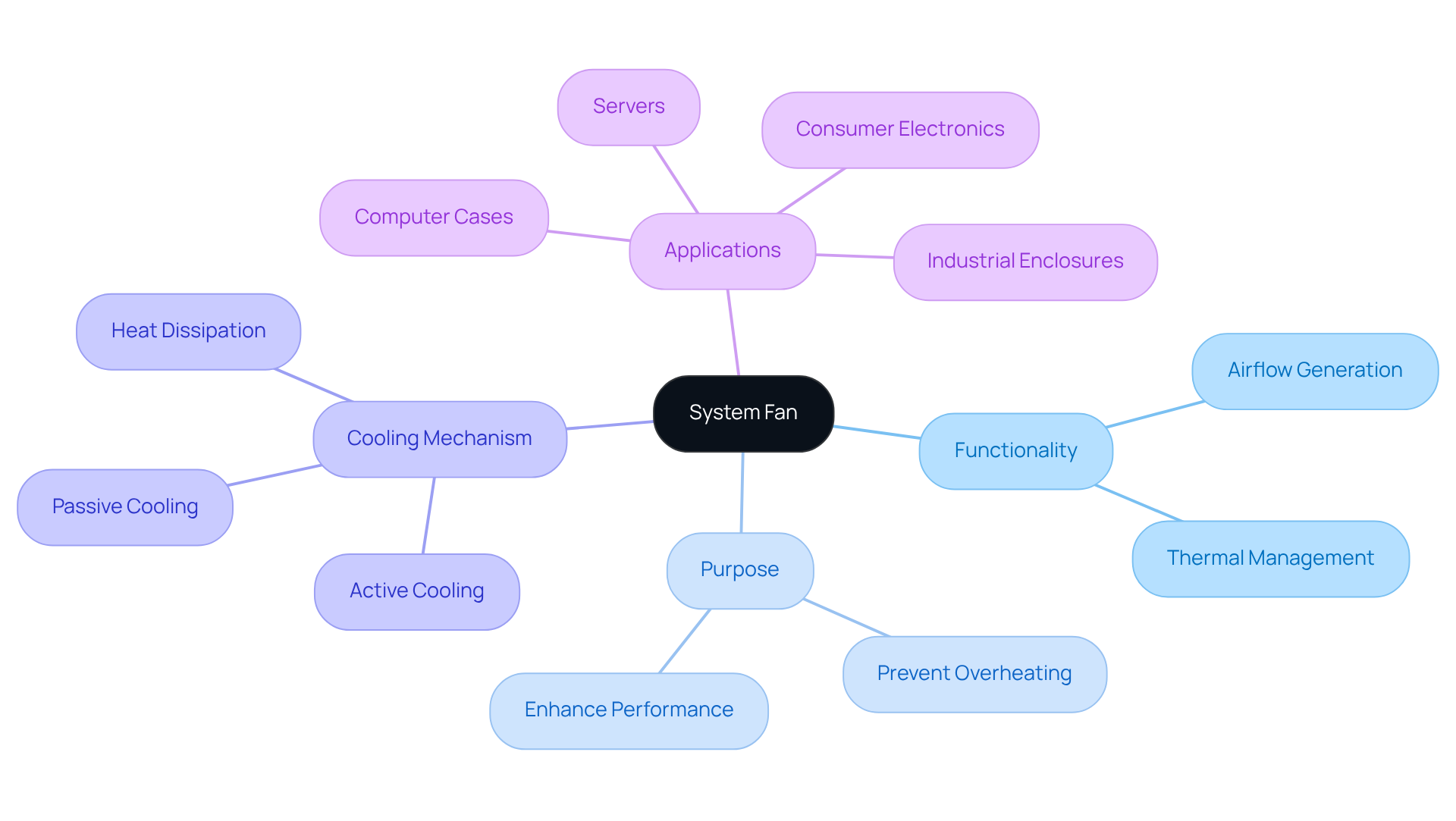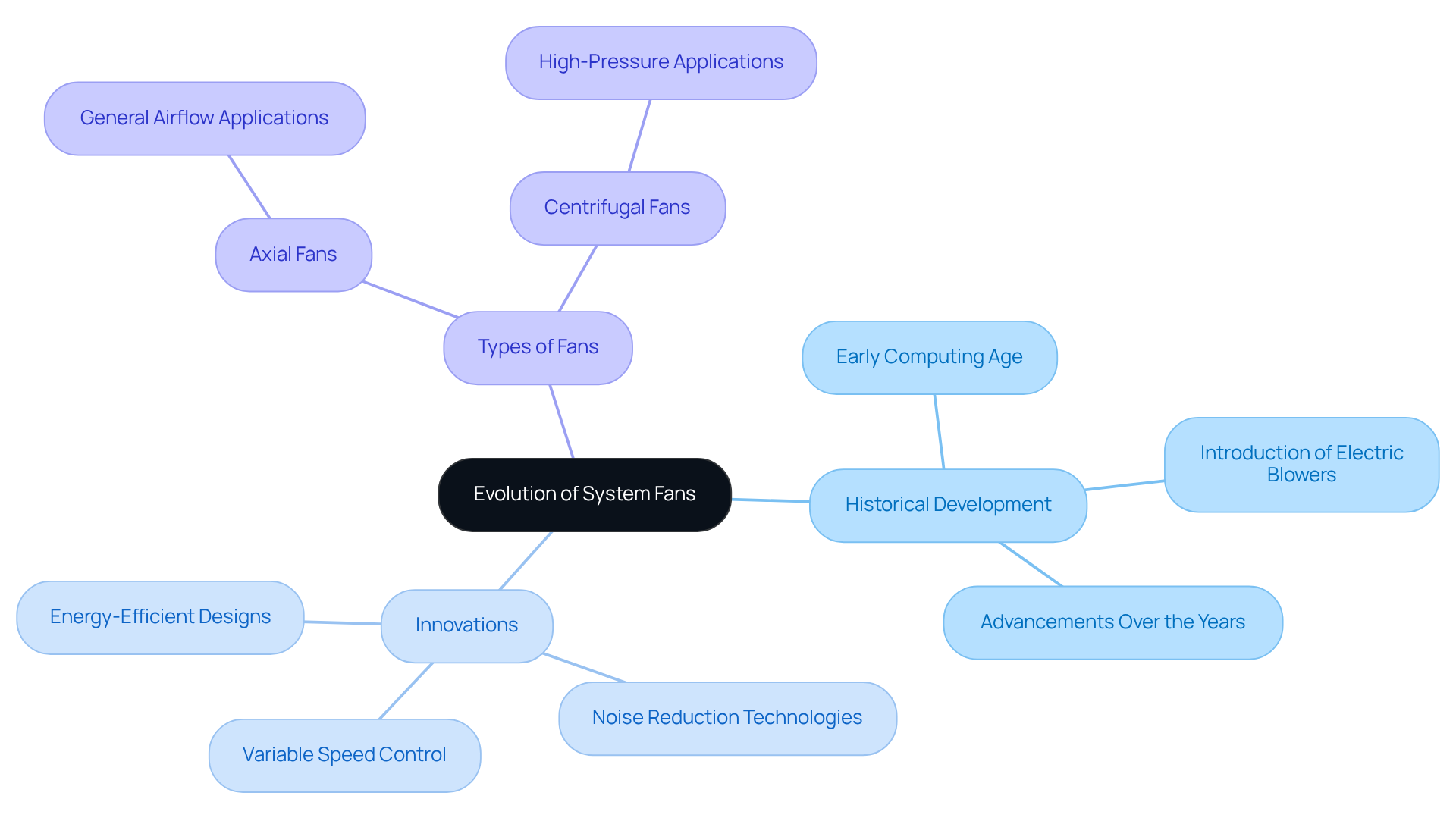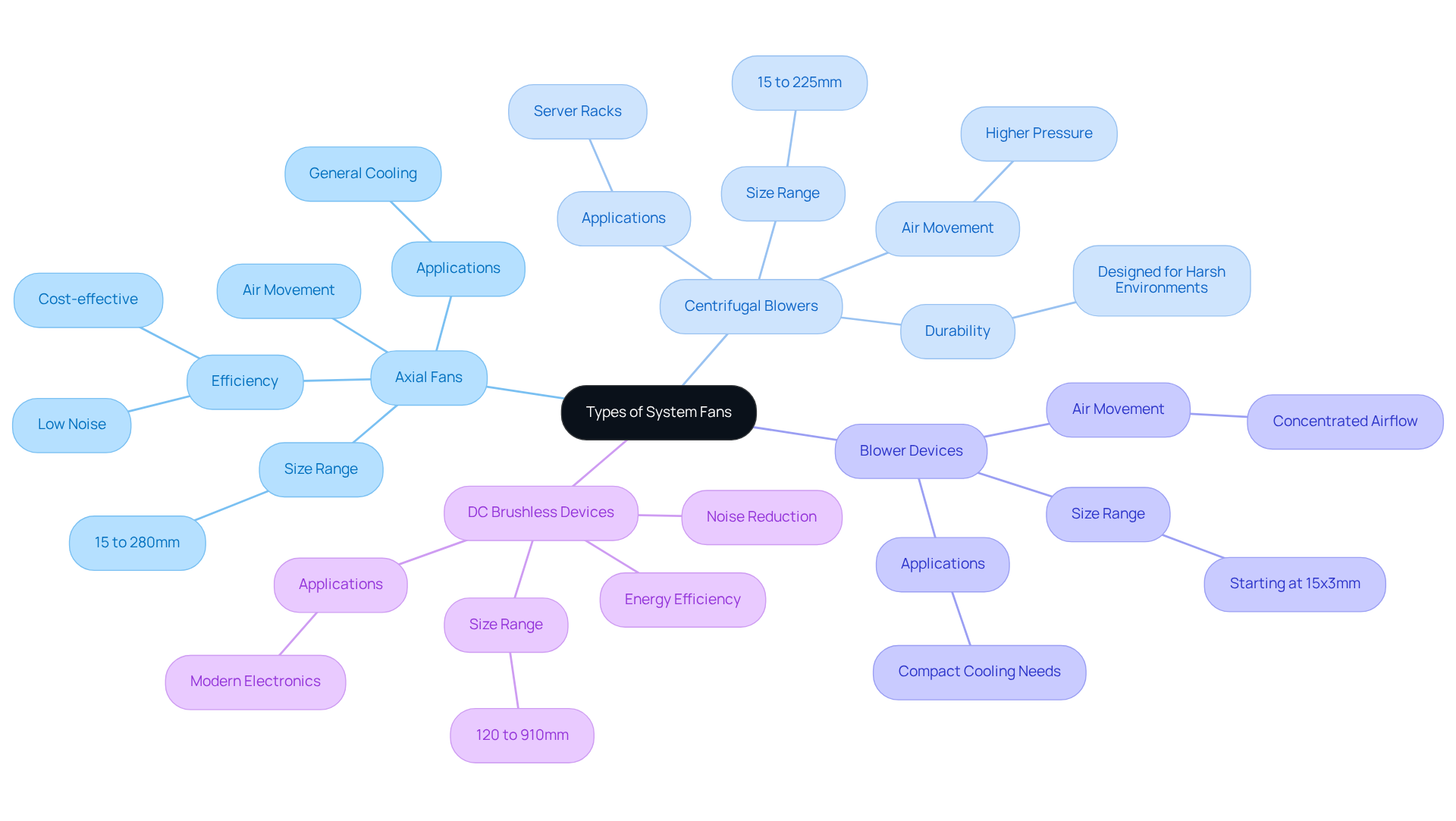Overview
A system fan serves as a vital mechanical device that generates airflow for cooling electronic components. By drawing in cooler air and expelling warmer air, it effectively prevents overheating. The significance of system fans in maintaining optimal temperatures for high-performance devices cannot be overstated. Recent advancements in fan technology have notably enhanced energy efficiency and thermal management, particularly in increasingly compact electronic systems. These developments underscore the necessity for effective cooling solutions in today’s advanced technological landscape.
Introduction
Understanding the intricate workings of electronic devices reveals a critical component that underpins their functionality: the system fan. These mechanical marvels are not merely accessories; they are essential for maintaining optimal temperatures, preventing overheating, and ensuring the longevity of high-performance components. As technology continues to evolve, the pressing challenge of managing heat in increasingly compact devices intensifies.
How do system fans adapt to these demands? What innovations are shaping their future? These questions set the stage for a deeper exploration of the vital role that system fans play in modern electronics.
Define System Fan: Core Functionality and Purpose
What is a system fan? It is a critical mechanical device designed to generate airflow within technological systems, primarily for the purpose of cooling. It operates by drawing cooler air from the environment and expelling warmer air generated by electrical components.
What is a system fan? It is essential for preventing overheating, which can lead to a decline in performance or even failure of sensitive components. Typically installed in computer cases, servers, and various enclosures, these fans ensure , thereby safeguarding the integrity and functionality of technological systems.

Contextualize System Fans: Importance in Electronics Cooling
In the electronics sector, efficient temperature management is paramount due to the significant heat generated by high-performance components like CPUs and GPUs. System cooling devices play a critical role in sustaining optimal temperatures, thereby enhancing the reliability and lifespan of electronic equipment. As technology advances, devices are becoming increasingly compact, which leads to higher heat densities. Without adequate , such as understanding what is a system fan, the risk of thermal throttling and hardware failure escalates.
For instance, reducing fan speed by approximately 800 RPM can lead to a 10.7% decrease in airflow, underscoring the necessity for precise temperature management. Moreover, power consumption drops to 58% at 50 Hz and 48% at 60 Hz when fan speeds are reduced through PWM control, illustrating the energy efficiency aspect of temperature management.
Electronically Commutated (EC) devices, capable of achieving efficiency levels of up to 90%, consume 70% less energy than traditional AC technology and automatically adjust their speed based on thermal demand, thereby reducing energy usage and enhancing performance. This adaptability is especially advantageous in high-performance electronics, where maintaining optimal thermal conditions is crucial.
The integration of high-capacity blowers, available from Gagner-Toomey in sizes ranging from 15mm to 225mm, has proven effective in optimizing thermal regulation and extending the lifespan of critical components. Therefore, understanding what is a system fan is crucial, as these components are not merely accessories; they are essential to electronic design, ensuring devices operate reliably under demanding conditions.

Trace the Evolution: Development and Variations of System Fans
The development of system blowers emerged during the early computing age when passive temperature management techniques proved inadequate for effective heat regulation. As processors evolved and their capabilities expanded, the demand for active cooling solutions led to the introduction of electric blowers. Over the years, system blowers have experienced significant advancements, showcasing innovations such as:
- Variable speed control
- Noise reduction technologies
- Energy-efficient designs
Axial fans are predominantly employed for general airflow, while centrifugal fans are tailored for high-pressure applications. This evolution underscores the persistent need for enhanced in increasingly sophisticated electronic systems, reflecting a broader trend in temperature control technologies that have adapted to the growing complexity of electronics.
Gagner-Toomey Associates stands at the forefront of this evolution, offering a comprehensive range of electronic solutions, including state-of-the-art temperature regulation systems from leading manufacturers. These solutions empower engineers to effectively address thermal management challenges.

Explore Types of System Fans: Selection for Specific Applications
System ventilators are essential components in electronics, available in various types tailored to specific applications based on air movement requirements and design constraints. The key types include:
- Axial Fans: These fans facilitate air movement parallel to their axis, making them suitable for general cooling applications. Their high ventilation rates and cost-effectiveness render them a preferred choice across diverse environments. Gagner-Toomey provides DC input Tube Axial units in sizes ranging from 15 to 280mm, optimized for performance, efficiency, and low noise, with IP protection options available upon request.
- Centrifugal Blowers: Designed to generate higher pressures, centrifugal blowers are ideal for applications requiring air movement through confined spaces, such as server racks. Gagner-Toomey’s comprehensive portfolio of DC input Centrifugal Blowers spans from 15 to 225mm, ensuring adaptability in various settings while enhancing durability and efficiency.
- Blower Devices: These units deliver concentrated airflow, frequently utilized in scenarios where space is limited but elevated airflow is critical. Gagner-Toomey’s miniature blower solutions cater to consumer applications and compact cooling needs, with sizes starting as small as 15x3mm.
- DC Brushless Devices: Recognized for their energy efficiency and quiet operation, DC brushless devices are increasingly preferred in contemporary electronics, particularly in applications where noise reduction is paramount. Gagner-Toomey’s offerings include EC fans and blowers ranging from 120 to 910mm, engineered to meet the demands of modern devices.
Understanding what a system fan is vital for selecting the appropriate type to ensure and maintain the performance of electronic devices. Gagner-Toomey Associates distinguishes itself as a premier provider of innovative cooling solutions for electronics and beyond, encompassing applications in the Automotive, Telecom/IT, and Energy sectors.

Conclusion
Understanding the role of a system fan in electronics underscores its fundamental importance in maintaining optimal operational conditions for various devices. These fans are not mere accessories; they are essential components that ensure effective airflow and cooling, ultimately preventing overheating and enhancing the reliability of sensitive electronic systems.
Throughout this article, we have discussed key insights, including:
- The critical functions of system fans in temperature management
- The evolution of fan technology
- The various types available for specific applications
The impact of efficient cooling solutions on performance and energy consumption has been highlighted, emphasizing how advancements in fan design contribute to the longevity and efficiency of electronic devices.
In a world where technology advances rapidly, recognizing the significance of system fans is crucial. As devices become more compact and performance demands increase, the need for effective thermal management solutions becomes paramount. Selecting the right system fan can make all the difference in ensuring that electronic equipment operates reliably and efficiently. This underscores the importance of informed decision-making in the realm of electronics cooling, prompting you to consider the implications of your choices in this critical area.
Frequently Asked Questions
What is a system fan?
A system fan is a mechanical device designed to generate airflow within technological systems, primarily for cooling purposes.
How does a system fan work?
A system fan operates by drawing cooler air from the environment and expelling warmer air generated by electrical components.
Why is a system fan important?
A system fan is essential for preventing overheating, which can lead to a decline in performance or even failure of sensitive components.
Where are system fans typically installed?
System fans are typically installed in computer cases, servers, and various enclosures to ensure effective thermal management.
What role does a system fan play in technological systems?
A system fan plays a crucial role in safeguarding the integrity and functionality of technological systems by managing temperature effectively.

